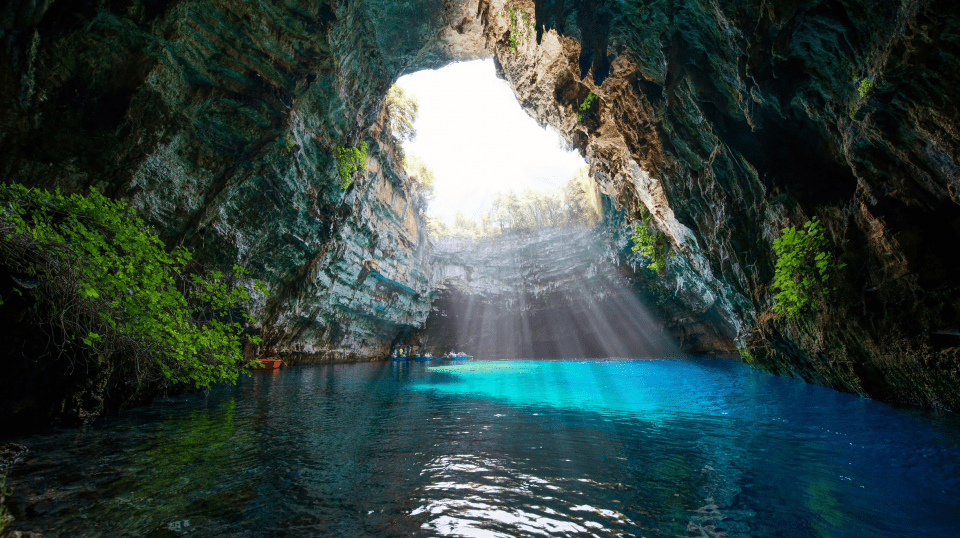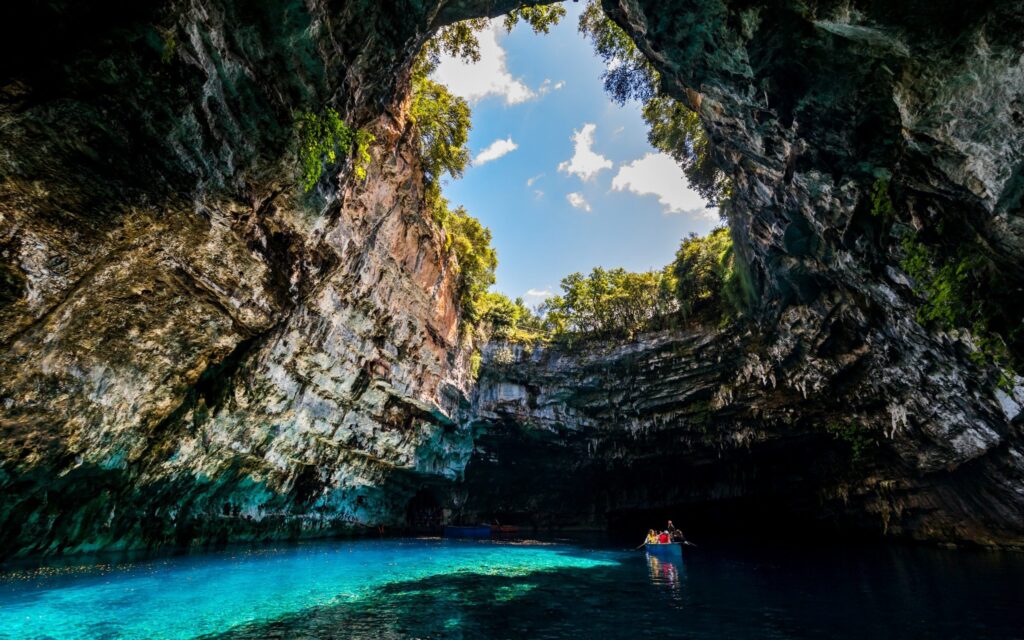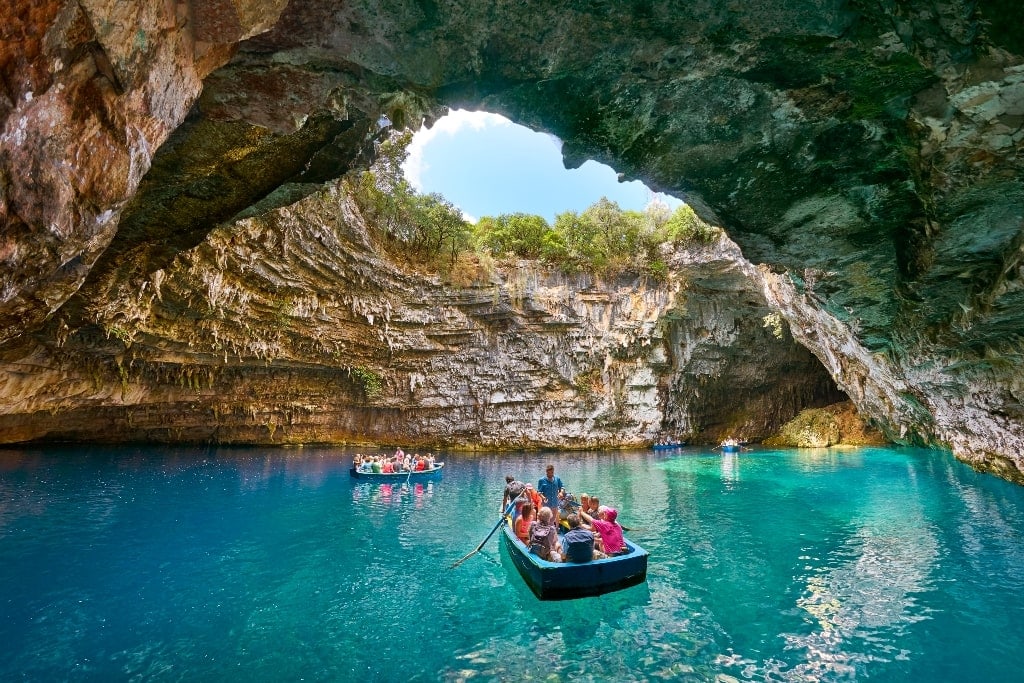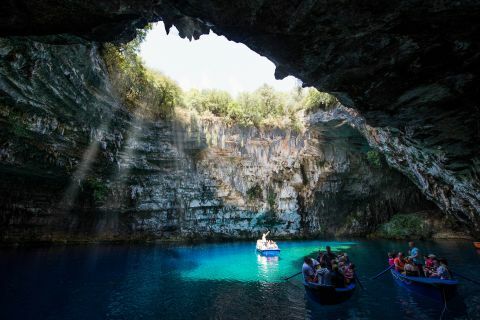Are you ready to embark on an underground adventure like no other? Get ready to be captivated by the hidden marvels nestled beneath the surface of the stunning Greek island of Kefalonia. With its vast cave networks just waiting to be explored, Kefalonia offers a truly unique and awe-inspiring experience for nature enthusiasts and adventure seekers alike. From the breathtaking stalactite formations in Melissani Cave to the mythical realm of Drogarati Cave, this enchanting exploration will leave you in awe of the incredible wonders that lie beneath the island’s picturesque landscapes. So grab your flashlight and let’s dive into the mesmerizing world of Kefalonia’s underground wonders.

1. Introduction to Kefalonia
1.1 Overview of Kefalonia
Welcome to the captivating island of Kefalonia, located in the mesmerizing Greek archipelago. Known for its stunning landscapes, crystal-clear waters, and rich cultural heritage, Kefalonia is truly a hidden gem waiting to be explored. This article will take you on a thrilling journey through the mesmerizing cave networks of Kefalonia, unveiling the fascinating geological formations, historical significance, and cultural importance that surround these underground wonders.
1.2 Geography and Location
Situated in the Ionian Sea, Kefalonia is the largest of the Ionian Islands, boasting a diverse terrain and breathtaking natural beauty. With its rugged mountains, lush forests, and pristine beaches, Kefalonia offers a paradise for nature enthusiasts and adventure seekers alike. The island is characterized by its unique geological formations, which have given rise to a network of captivating caves that lie hidden beneath the surface.
1.3 History and Culture
Deeply rooted in history and culture, Kefalonia has a fascinating past that has shaped its heritage. Throughout the centuries, the island has been influenced by various civilizations, including the Venetians, the Byzantines, and the Ottomans. This rich tapestry of historical influences is evident in the island’s architecture, traditions, and festivals. Kefalonia is also renowned for its warm hospitality, ensuring that visitors feel welcome and immersed in the local culture.
2. Cave Networks in Kefalonia
2.1 Importance of Cave Networks
The cave networks of Kefalonia hold immense geological, ecological, and cultural importance. These underground systems offer a unique glimpse into the island’s geological history and provide valuable insight into the formation of the island itself. Additionally, the caves serve as crucial habitats for various plant and animal species, contributing to the island’s biodiversity. Furthermore, the caves have played a significant role in the island’s mythology and have been revered as sacred places by ancient civilizations.
2.2 Types of Caves in Kefalonia
Kefalonia is home to a diverse range of caves, each with its own distinct characteristics and features. From limestone caves to sea caves and underground rivers, the island offers a plethora of underground wonders waiting to be explored. The caves vary in size, with some featuring vast chambers adorned with intricate stalactite and stalagmite formations, while others invite visitors to delve into narrow passageways and underground pools.
2.3 Formation of Cave Networks
The formation of the cave networks in Kefalonia is a fascinating geological process that has occurred over millions of years. These captivating underground chambers are primarily a result of the dissolution of limestone rocks by water. As rainwater seeps through the porous rocks, it gradually dissolves the limestone, creating passages and chambers underground. Over time, the continuous flow of water gives birth to stunning stalactites, stalagmites, and other breathtaking formations that adorn the inner walls of the caves.
3. Melissani Cave
3.1 Description of Melissani Cave
One of the most iconic and enchanting caves in Kefalonia is Melissani Cave. Nestled near the village of Karavomylos, Melissani Cave is a mesmerizing underground lake that captivates visitors with its turquoise waters and ethereal beauty. The cave’s roof has partially collapsed, creating an opening known as a “katavothra,” through which sunlight streams, illuminating the lake and casting enchanting reflections on its surface.
3.2 Geological Features
Melissani Cave is characterized by its exquisite geological features, including stalactites, stalagmites, and columns. These formations, created over thousands of years, add to the cave’s mystique and allure. The turquoise waters of the lake, combined with the intricate reflections and the surrounding rock formations, create a breathtaking visual spectacle that leaves visitors in awe.
3.3 History and Mythology
Melissani Cave has a rich history and mythology. In ancient times, the cave was dedicated to the nymph Melissani, hence its name. According to Greek mythology, Melissani was a nymph who drowned herself in the lake due to her unrequited love for the god Pan. The history of the cave goes beyond ancient mythology, with artifacts dating back to the 3rd and 4th centuries BCE being discovered within its depths. Today, visitors can explore the cave by boat and immerse themselves in the captivating stories and legends surrounding its ancient origins.
4. Drogarati Cave
4.1 Overview of Drogarati Cave
Another awe-inspiring cave on the island of Kefalonia is Drogarati Cave. Located near the village of Haliotata, this majestic underground chamber has been captivating visitors for centuries with its grandeur and unique features. Drogarati Cave welcomes explorers with its impressive stalactites and stalagmites, as well as its remarkable acoustics.
4.2 Unique Geological Formations
Drogarati Cave is renowned for its stunning geological formations, which have been sculpted over thousands of years. The cave’s interior is adorned with an array of striking stalactites and stalagmites that form intricate shapes and patterns. These formations continue to grow as mineral-rich water slowly drips from the cave’s ceiling, adding to the cave’s ethereal beauty.
4.3 Concerts and Events
One of the unique features of Drogarati Cave is its exceptional acoustics. The cave’s natural amplification and echo make it a perfect venue for concerts and events. Over the years, the cave has hosted various musical performances, showcasing the immense beauty of both the cave and the music. Attending a concert within the depths of Drogarati Cave promises an unforgettable experience, where the fusion of music and nature creates a magical atmosphere.

5. Cave of Agios Gerasimos
5.1 Significance of Agios Gerasimos Cave
The Cave of Agios Gerasimos holds great religious and cultural significance on the island of Kefalonia. Situated near the village of Valsamata, this sacred cave is closely associated with Agios Gerasimos, the patron saint of the island. The cave is believed to be the place where the saint spent many solitary hours in prayer and meditation, and it continues to attract pilgrims who seek spiritual solace and inspiration.
5.2 Religious Importance
The Cave of Agios Gerasimos is a revered pilgrimage site for Orthodox Christians. It is considered a place of great spiritual power and is believed to be a conduit for divine intervention. Pilgrims visit the cave to seek blessings, healing, and guidance from the saint. The cave’s serene ambiance and sacred aura create an atmosphere of tranquility and devotion, allowing visitors to connect with their spirituality on a profound level.
5.3 Pilgrimages and Festivals
Throughout the year, the Cave of Agios Gerasimos becomes a focal point for pilgrimages and festivals. On the 16th of August, the feast day of Agios Gerasimos, a grand procession takes place, during which the saint’s relics are carried from the cave to the monastery dedicated to him. Pilgrims from all corners of Kefalonia and beyond participate in this religious procession, showcasing the island’s deep-rooted faith and devotion.
6. Cave of Agios Andreas
6.1 Exploring Agios Andreas Cave
The Cave of Agios Andreas, located near the village of Poros, offers an extraordinary underground adventure for visitors to Kefalonia. This cave, known for its historical significance, invites explorers to delve into its depths and uncover the secrets hidden within its chambers.
6.2 Historical Significance
The Cave of Agios Andreas holds great historical importance, as it is believed to have served as a place of refuge and worship during the Byzantine era. It is said that the cave was used as a hiding place by local villagers during invasions and served as a secret place of worship during times of religious persecution. The cave’s walls bear witness to the passage of time, with inscriptions and graffiti dating back centuries.
6.3 Preservation Efforts
Efforts are underway to preserve and protect the historical and cultural heritage of the Cave of Agios Andreas. Archaeologists and conservationists are working tirelessly to study and restore the cave, ensuring that future generations can continue to appreciate its historical significance. Visitors are encouraged to respect the cave’s cultural value and contribute to its preservation by adhering to designated paths and guidelines during their exploration.

7. Cave of Zervati
7.1 Zervati Cave: A Hidden Gem
Tucked away in the hills of Kefalonia lies the hidden gem of Zervati Cave. Located near the village of Kourkoumelata, this lesser-known cave offers a unique and off-the-beaten-path experience for adventurous explorers. With its serene ambiance and natural beauty, Zervati Cave is a true hidden treasure waiting to be discovered.
7.2 Unique Rock Formations
Zervati Cave is renowned for its extraordinary rock formations, which have been sculpted over centuries. The cave’s interior showcases an array of stunning stalactites and stalagmites that create an otherworldly atmosphere. As visitors traverse the cave’s pathways, they are greeted with a breathtaking display of intricate shapes and patterns, showcasing the incredible forces of nature at work.
7.3 Ecological Considerations
As a site of ecological importance, Zervati Cave is home to various plant and animal species that have adapted to thrive in its unique environment. It is essential that visitors to the cave respect and preserve its natural habitat. Explorers are encouraged to stay on designated paths, avoid touching or removing any natural formations, and refrain from leaving any litter behind. By practicing responsible tourism, visitors can contribute to the conservation efforts and ensure the continued preservation of Zervati Cave’s delicate ecosystem.
8. Cave of Paliostafida
8.1 Paliostafida Cave: An Adventure Underground
For those seeking an adrenaline-pumping underground adventure, the Cave of Paliostafida is an ideal destination. Located near the village of Klismata, this cave promises an unforgettable experience for thrill-seekers and nature enthusiasts alike. With its mysterious dark passages and captivating geological formations, Paliostafida Cave offers a one-of-a-kind adventure into the depths of Kefalonia’s underground world.
8.2 Exploring the Interior
The interior of Paliostafida Cave is a labyrinth of narrow passageways and chambers, waiting to be explored. Equipped with appropriate safety gear and accompanied by experienced guides, visitors can navigate through the cave’s dark corridors, discovering hidden chambers and marveling at the awe-inspiring stalactites and stalagmites that adorn the cave’s walls. The adventure of exploring Paliostafida Cave provides a thrilling opportunity to witness the sheer power and beauty of nature.
8.3 Wildlife and Biodiversity
Paliostafida Cave serves as a habitat for a diverse range of wildlife and contributes to the island’s biodiversity. The cave provides shelter for various bat species, which play a crucial role in the ecosystem by helping to control insect populations. Bird species such as owls and falcons are also known to reside in the cave. Explorers are urged to respect the cave’s fauna and refrain from disturbing or harming any wildlife encountered during their visit.

9. Cave of Agia Sofia
9.1 Unveiling the Mysteries of Agia Sofia Cave
Nestled in the tranquil village of Kateleios, the Cave of Agia Sofia invites intrepid explorers to embark on a journey deep into its mysterious depths. Revered for its historical and archaeological significance, this cave offers a captivating window into the island’s rich past, unraveling ancient mysteries that have remained hidden for centuries.
9.2 Archaeological Discoveries
The Cave of Agia Sofia has yielded fascinating archaeological discoveries that shed light on the island’s history and civilization. Excavations within the cave have uncovered ancient artifacts dating back to the Neolithic period, including pottery fragments, tools, and human remains. These discoveries provide valuable insights into the lives and customs of the ancient inhabitants of Kefalonia, offering a glimpse into the island’s rich cultural heritage.
9.3 Research and Exploration
The exploration and ongoing research of Agia Sofia Cave continue to unravel its mysteries and contribute to our understanding of the island’s past. Archaeologists and scientists are tirelessly working to uncover and preserve the cave’s archaeological treasures, ensuring that its historical significance is not lost to time. Visitors to Agia Sofia Cave can witness the ongoing research efforts firsthand and gain a deeper appreciation of the importance of preserving Kefalonia’s cultural heritage.
10. Exploration Tips and Safety Guidelines
10.1 Planning an Excursion to Cave Networks
When planning an excursion to explore the cave networks of Kefalonia, it is essential to research and gather information about the caves you wish to visit. Familiarize yourself with their accessibility, opening hours, and any guided tours that may be available. Additionally, ensure that you are physically prepared for the adventure, as some caves may require moderate to strenuous physical activity.
10.2 Necessary Equipment and Clothing
To fully enjoy the exploration of Kefalonia’s caves, it is important to have the appropriate equipment and clothing. Some essential items to consider include sturdy and comfortable footwear, as well as a headlamp or flashlight to navigate the dark interiors of the caves. Additionally, it is advisable to wear layered clothing to accommodate the varying temperatures within the caves and to carry a small backpack for water, snacks, and any necessary safety equipment.
10.3 Safety Precautions and Guidelines
Exploring caves can be an exhilarating experience, but it is crucial to prioritize safety at all times. Always follow designated paths and avoid venturing off on your own. If guided tours are available, consider joining one to ensure a safe and informative exploration of the caves. Be mindful of your surroundings, watch your footing, and exercise caution when maneuvering through narrow passages. Finally, respect the fragile ecosystem of the caves by refraining from touching or removing any natural formations and preserving the cleanliness of the cave environment.
In conclusion, the cave networks of Kefalonia offer a captivating adventure into the hidden world beneath the island’s surface. From the enchanting Melissani Cave to the historically significant Cave of Agios Andreas, each cave holds its own unique allure and charm. Exploring these underground wonders allows visitors to appreciate the geological marvels, uncover the mysteries of the past, and immerse themselves in the rich culture and heritage of Kefalonia. Whether you are an avid spelunker or a curious traveler, the cave networks of Kefalonia are sure to leave you in awe of nature’s astonishing creations. So pack your sense of adventure and embark on a journey to discover the mesmerizing underground wonders of Kefalonia!

